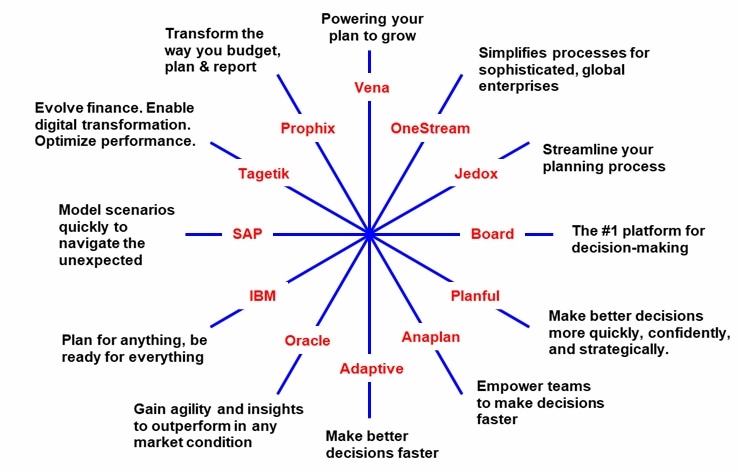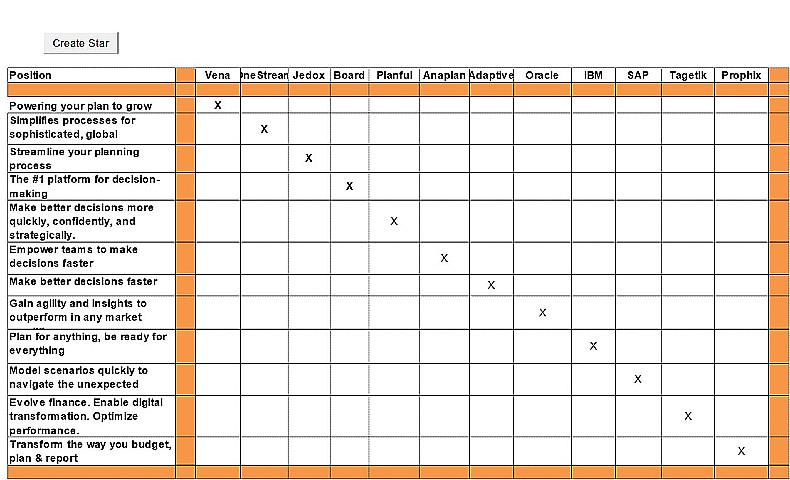When was the last time you did an assessment of how your competitors are positioned relative to your product or company?
If you haven't done a competitor positioning assessment recently, you're not alone. It's an element of competitive analysis that is often overlooked.
"Too many companies embark on marketing and advertising as if the competitor's position did not exist. They advertise their products in a vacuum and are disappointed when their messages fail to get through," observe Al Ries and Jack Trout in their marketing classic Positioning: The Battle for your Mind.
Claiming your own unique position can make a big difference in the effectiveness of your marketing and the success of your sales efforts. The decision-making portion of the brain seeks evidence to make a quick decision, according to Christophe Morin's and Patrick Renvoise's Neuromarketing. When competing companies make similar marketing and sales claims, the buyer's brain enters a state of confusion, leading to prolonged sales cycles, price wars, or no decision at all.
But how do you know whether your position differentiates your company, product, or service?
Using the leading companies in the Cloud-based financial planning & analysis (FP&A) market as examples of effective and ineffective positions, this article explains how to determine your competitors' positions and the best way to present those findings.
Once you know how to determine your competitors' positioning, you can use a technique I call "perceptual mapping" to see how a particular company is positioned relative to its competitors.
This is my perceptual map for the FP&A market.

Before we go further, let me share my definition of positioning: It's the mental space in your target audience's mind you can occupy by using a positioning statement that expresses a benefit that solves a pressing problem for the audience. In that mental space, your solution meets the audience's problem and forms a meaningful connection between the two.
Your position should be the foundation for everything you do in marketing. Use it as the theme for all your marketing communications so that you take advantage of the power of consistency and repetition. (Neuromarketing explains that when you repeat your position often, your listeners' brains earmark it as important and remember it.)
Evaluating websites is the fastest, easiest way to determine your competitors' positioning. A positioning statement frequently appears in a prominent place on the homepage of a website. A good one contains a focused benefit idea or concept that solves a real business challenge and, ideally, the target audience's No. 1 problem.
An effective positioning statement should be a short, declarative sentence that expresses a benefit that solves a pressing target audience problem. Some examples:
- Eckerson Group helps your organization get more business value from data and analytics through strategic consulting, thought leadership, and education.
- inRiver is the fastest, easiest way to create product marketing content that makes your buyers want to buy more.
- Kit Software helps maximize the value of your commodity trading operations.
For each of your competitors, analyze website elements such as the product page, solutions page, the "why us?" page, and the "about us" page. If you need to do a deep dive, you can evaluate other marketing communications, such as emails, webinar invitations, brochures, banner ads, and press announcements.
What follows are FP&A examples with links to actual content that will help you better understand how to determine a company's position.
My evaluation found that only one FP&A company uses the power of consistency and repetition effectively: Vena. Throughout its website, Vena emphasizes its "helps you grow" position. The dominant copy on Vena's homepage: "Vena brings your people, processes, and systems into a complete planning platform so you can grow anywhere together."
As you scroll down, you find the following headlines:
- Hit the ground growing
- Jumpstart your growth journey
- Join over 800 companies on the journey to growth with Vena
Vena, therefore, is positioned around the notion of growth. The reason I chose the phrase "powering your plan to grow" for the perceptual map is this headline on the Financial Planning and Analysis page: "FP&A Software for Powering Your Plan to Grow."
Prophix expresses its position boldly on its homepage: "Transform the way you budget, plan & report."
To make the claim stick, Prophix should explain how it transforms budgeting, planning, and reporting. But there no proof provided on the website—no substantiation of the transformation claim.
It's easy to figure out Board's position, because the "#1 platform for decision-making" claim is prevalent throughout the website, from the homepage to the platform page and the about us page.
Once you have determined the position for each competitor, organize the claims in a table. Some competitors are likely to have similar or even identical positioning statements. Other competitors may publish various claims, making it more difficult to determine how they are positioned, if at all. A common mistake by companies is to make two or more benefit claims of equal importance, so check for those, too.
Here is a table for the FP&A market created in my perceptual mapping application.

Once I filled out the table, I clicked on the "Create Star" button to create the perceptual map you saw earlier in this article. Just like that, we have completed the initial assessment of that competitive landscape!
But the work is far from over. You should do a quick scan of your competitors' websites at least once a month to determine whether they have changed their position.
You may be surprised to discover how often your competitors change positions—or even copy yours!
But if they do, your position is no longer unique. Then what?
Stick with your position. Why? If the copycat competitor has changed positions so quickly, it is likely to change again soon enough. In that sense, you can view the encroachment as a positive—because competitors that copy your position lack the discipline necessary to claim a unique position, which takes time (at least 18 months) and singlemindedness. Rather than use their position (which is also yours) consistently to repeat the benefit over and over, they are instead likely to have a shotgun approach: i.e., lots of benefits that end up diluting their overall position.
So, that shotgun approach results in essentially no position, because your target audiences won't remember it. What they will remember is your position if you are using the power of repetition to reinforce it. They may even think your competitor is stealing your claim (which it is doing).
Regardless of what competitors are changing their positions to, you'll want to know as soon as possible. A change indicates that you should check out that competitor in more detail. It could signal a management shakeup, a firing of the CMO while a new one is going in a new direction, or a change in the company's overall strategy.
Monitoring your competitors' positioning on a regular basis is a process that should be embraced rather than overlooked. It is the foundation of your competitive intelligence efforts because it provides so much more insight than just whether your position is unique.
More Resources on Competitor Positioning
The Key to Successful Positioning: '3Cs' Research
How to Unleash the Power of Brand Repositioning: A Four-Phase Process
How to Position Your B2B Brand for Search: Garrett Mehrguth on Marketing Smarts [Podcast]




